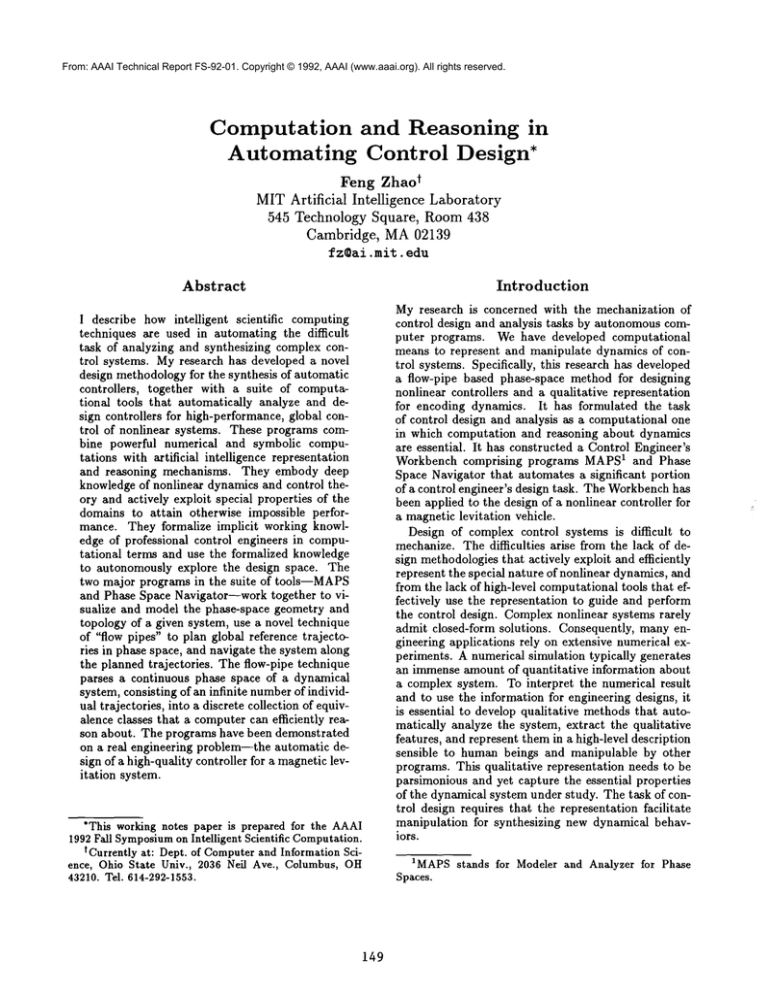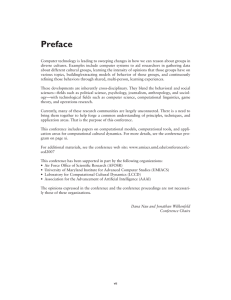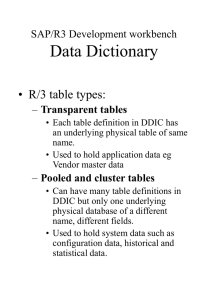
From: AAAI Technical Report FS-92-01. Copyright © 1992, AAAI (www.aaai.org). All rights reserved.
Computation
Automating
and Reasoning
in
Control Design*
tFeng Zhao
MIT Artificial
Intelligence
Laboratory
545 Technology Square,
Room 438
Cambridge,
MA 02139
fz@ai, mit. edu
Introduction
Abstract
I describe how intelligent
scientific computing
techniques are used in automating the difficult
task of analyzing and synthesizing complex control systems. Myresearch has developed a novel
design methodologyfor the synthesis of automatic
controllers, together with a suite of computational tools that automatically analyze and design controllers for high-performance, global control of nonlinear systems. These programs combine powerful numerical and symbolic computations with artificial intelligence representation
and reasoning mechanisms. They embody deep
knowledgeof nonlinear dynamics and control theory and actively exploit special properties of the
domains to attain otherwise impossible performance. They formalize implicit working knowledge of professional control engineers in computational terms and use the formalized knowledge
to autonomously explore the design space. The
two major programs in the suite of tools--MAPS
and Phase Space Navigator--work together to visualize and model the phase-space geometry and
topology of a given system, use a novel technique
of "flow pipes" to plan global reference trajectories in phase space, and navigate the system along
the planned trajectories. The flow-pipe technique
parses a continuous phase space of a dynamical
system, consisting of an infinite numberof individual trajectories, into a discrete collection of equivalence classes that a computercan efficiently reason about. The programs have been demonstrated
on a real engineering problem--the automatic design of a high-quality controller for a magneticlevitation system.
*This working notes paper is prepared for the AAAI
1992Fall Symposium
on Intelligent Scientific Computation.
iCurrently at: Dept. of Computerand Information Science, Ohio State Univ., 2036 Neil Ave., Columbus, OH
43210. Tel. 614-292-1553.
149
My research is concerned with the mechanization of
control design and analysis tasks by autonomous computer programs. We have developed computational
means to represent and manipulate dynamics of control systems. Specifically, this research has developed
a flow-pipe based phase-space method for designing
nonlinear controllers and a qualitative representation
for encoding dynamics. It has formulated the task
of control design and analysis as a computational one
in which computation and reasoning about dynamics
are essential. It has constructed a Control Engineer’s
1 and Phase
Workbench comprising programs MAPS
Space Navigator that automates a significant portion
of a control engineer’s design task. The Workbenchhas
been applied to the design of a nonlinear controller for
a magnetic levitation vehicle.
Design of complex control systems is difficult to
mechanize. The difficulties arise from the lack of design methodologiesthat actively exploit and efficiently
represent the special nature of nonlinear dynamics, and
from the lack of high-level computational tools that effectively use the representation to guide and perform
the control design. Complex nonlinear systems rarely
admit closed-form solutions. Consequently, many engineering applications rely on extensive numerical experiments. A numerical simulation typically generates
an immense amount of quantitative information about
a complex system. To interpret the numerical result
and to use the information for engineering designs, it
is essential to develop qualitative methods that automatically analyze the system, extract the qualitative
features, and represent them in a high-level description
sensible to human beings and manipulable by other
programs. This qualitative representation needs to be
parsimonious and yet capture the essential properties
of the dynamical system under study. The task of control design requires that the representation facilitate
manipulation for synthesizing new dynamical behaviors.
1MAPSstands for Modeler and Analyzer for Phase
Spaces.
From: AAAI Technical Report FS-92-01. Copyright © 1992, AAAI (www.aaai.org). All rights reserved.
The modern geometric theory of dynamical systems
pioneered by Poincar~ provides a qualitative way to describe the rich dynamical behaviors of nonlinear systems. Abelson et ai. described a collection of computer programs that analyze dynamical systems in
phase space at the level of expert dynamicists lAbelson, 1989]. The task of control design, however, imposes stronger requirements on the form and use of
the representation of the dynamics: the phase-space
geometry and topology of a dynamical system should
be represented in a way that allows for efficient computational manipulations for the purpose of control design. Nonlinear systems can have extremely convoluted phase-space geometries; the complexity becomes
much worse as the dimensionality increases. Humans
can comfortably picture and manipulate two and threedimensional objects with the aid of graphic, geometric
modeling techniques. For higher-dimensional systems,
however, few visualization and manipulation tools exist. Automatic modeling, analysis, and design tools
are necessary to identify, extract, and reason about
the spatial properties of phase space.
Research
sis for estabhshing reference trajectories, and navigates the system along the planned reference trajectories. The phase-space design approach requires
powerful computational tools that are able to identify, extract, represent, and manipulate qualitative
features of phase space.
¯ This work has constructed a computational environment, the Control Engineer’s
Workbench,
integrating a suite of programs that automatically
analyze and design high-performance, global controllers for a large class of nonlinear systems. These
programs combine powerful techniques from numerical and symbolic computations with novel representation and reasoning mechanisms of artificial
intelligence.
The two major components in the
Workbench--MAPS and Phase Space Navigator-work together to visualize and model the phasespace geometry and topology of a given system.
They reason about and manipulate the phase-space
geometry and topology and search for optimal control paths connecting initial state and the desired
state for the system. The Workbenchrepresents the
result of design and analysis in a symbolic form manipulable by other programs, and produces a highlevel summarymeaningful to professional engineers.
It also presents the result in a graphical form.
The Workbench embodies domain knowledge from
control engineering and dynamical systems theory.
It understands concepts like asymptotic and transient behaviors, stability regions, reachable sets, convergence, overshooting, etc. The Workbench organizes the modules of analysis, design, and graphics
presentation around the control task and encourages
incremental changes to the Workbench, for example,
incorporating programs tailored to particular applications and encoding knowledgeof specific domains.
Suppose we want to use the Workbench to design
electric power control systems. In addition to their
differential equation models, the power systems have
special structural properties and model formulations
that can be exploited to reduce design complexity
and improve design quality. Special program fragments exploiting these properties can be integrated
~into the Workbench. The integration is made possible and easier by the underlying Scheme implementation as a substrate.
The Scheme programming
language facilitates composition and abstraction of
procedures.
Summary
The work reported in [Zhao, 1991a; Zhao, 1991b;
Zhao, 1992a] demonstrates that the difficult control design and analysis tasks can be automated, using a suite
of computer programs that actively exploit knowledge
of nonlinear dynamics and phase space. These programs combine numerical and symbolic computations
with spatial-reasoning
techniques. The research is
summarizedas follows:
¯ This work has developed a phase-space qualitative
representation for complex behaviors of dynamical systems and a design language for computationally expressing and manipulating these behaviors. The qualitative representation captures the
gross aspects of dynamics in a relational graph of
phase-space structure and a set of discrete objects
called flow pipes---the equivalence classes of behaviors. The design language describes a control design
task in terms of well-defined geometric, combinatorial operations on the flow pipes. This language
helps formalize aspects of implicit expert reasoning
of control engineers in solving control design problems. The representation and the language are developed independently of the orders of systems, i.e.,
the dimensionality of phase spaces.
The qualitative representation and the design language enable us to develop a phase-space design
methodology for the synthesis of control systems.
The methodology designs a prespecified
control
law--control reference trajectories--for
a system by
synthesizing the desired shape for phase-space geometry dictating trajectory flows. It uses the flow
pipes to group infinite numbersof distinct behaviors
into a manageable discrete set that becomesthe ba-
¯ This work has demonstrated the Workbench in an
application of great practical interest: the Workbench helped design a high-quality controller for
a magnetic levitation
system--the German Transrapid system. The controller synthesized by the
Workbench outperforms the one manually designed
for the same system by professional control engineers: our controller stabilizes the maglev vehicle
with much larger initial displacements than those
150
From: AAAI Technical Report FS-92-01. Copyright © 1992, AAAI (www.aaai.org). All rights reserved.
allowed in the manual design using classical linear
feedback technique [Zhao and Thornton, 1992b].
Reasoning
about Control
Design
Howdoes a control expert reason about a control design task? A professional control engineer uses a body
of specialized knowledge to carry out the design. The
engineer develops insight through an analysis of the
physical system, uses the insight to explore the design space constrained by control requirements, and
makes engineering judgment about design choices and
trade-offs. A particularly intuitive design method is
the phase-plane method for analyzing and designing a
second-order nonlinear control system in a phase plane.
The engineer goes through the following steps with
the phase-plane method:
¯ simulate the system extensively with different initial
conditions
¯ plot the behaviors in trajectories on a piece of paper
¯ interpret the result with visual inspection
¯ design a control law to obtain desired behavior.
The phase-plane method is a useful tool for analyzing qualitative responses of a control system. It
is, however, manual, prohibitively expensive, and confined to two-dimensional planes. Although a diagrammatical sketch of a phase plane illustrates just the qualitative aspects of the system, to obtain the phase-plane
sketch means lots of humaneffort in preparing numerical simulations, collecting the numbers, sketching the
results on papers, analyzing the trajectory plot, and
interpreting it in a qualitative picture. Worse, this
method becomes useless in cases when the order of a
system is greater than two and the nonlinearity results
in convoluted phase-space geometry. The mechanization of the task with autonomous computer programs
would alleviate manyof these restrictions.
The Control Engineer’s Workbench formulates in
computational terms the informal working knowledge
of professional control engineers in analyzing complex
control systems, in particular, in the form of the phaseplane method.
A Real Scenario
name:
buckling_column
equation_of
_motion:
dzl/dt = x2
dz2/dt -plzl - p2z~ - P3z2 + u
state_variable :
state_variable :
parameter:
Xl
z2
Pl = -2.0
parameter:
parameter:
parameter:
bounding_box
:
P2----1.0
/93= 0.2
u ---- 0.0
Zl 6 [-3.O, 3.O],
x2 q [-4.0,4.0]
The Workbenchmodels the trajectory flows of the
system and reports the following summary:
flow-pipes:
I. flov-pipe from *infinity* to (1.41 0.):
flow-pipe-boundary:
trajectory l:(from *infinity* to (0. 0.))
trajectory 2: (from *infinity* to (0. 0.))
2. flow-pipe from *infinity* to (-1.41 0.):
flow-pipe-boundary:
trajectory I: (from *infinity* to (0. 0.))
trajectory 2: (from *infinity* to (0. 0.))
The Workbenchalso displays the phase portrait of
the system showing flow pipe 2, consisting of all
the trajectories that end at the left-hand attractor
(see Figure 1).
with the Workbench
The Control Engineers’ Workbench automates a significant portion of the control engineer’s analysis and
design tasks. In the following scenario, the Workbench
autonomously analyzes the buckling motion of a steel
column under compression.
The Engineer types in the model for the elastic
column buckling under axial compressive force and
asks the Workbenchto analyze the system for the
given parameter values.
Figure 1: The phase portrait of the buckling column, automatically generated by the Control Engineer’s Workbench.
Like the phase-plane analysis discussed earlier, the
Workbenchis able to reason about dynamics in terms
151
From: AAAI Technical Report FS-92-01. Copyright © 1992, AAAI (www.aaai.org). All rights reserved.
of phase-space geometries. It partitions a phase space
into discrete regions. It generates a high-level picture
of the phase portrait in Figure 1. The picture contains essentially the same kind of information as one a
professional would produce.
But unlike the phase-plane method, the Workbench
provides computational means for modeling the dynamics. It decomposesthe phase space into subregions
that can even be globally nonlinear. The Workbenc~h
internally represents the critical points and geometries
of the regions in a data structure that allows other
programs to manipulate, visualize, and communicate
with human users. Because the geometry of a system’s phase space is modeled with a simplicial structure, the representation and reasoning mechanismsfor
this structure are independent of the dimensionality of
phase space. Reference [Zhao, 1992a] details a synthesis algorithm for designing control systems using the
phase-space modeling.
been proven essential.
In order to fully exploit
the dynamics and to build programs to imitate human control designers, the Workbench uses whatever knowledge and techniques that are necessary:
geometric theory of dynamical systems, control theory, and techniques from artificial intelligence, vision, computational geometry, numerical analysis,
and graph search.
¯ The complexities of the control design task necessitate the need for automatic modeling and analysis
tools. Autonomousprograms like those in the Workbench have extended the capabilities of the "eyes"
and "hands" of control engineers in seeing and manipulating objects. They have enlarged the design
space engineers can explore. In certain cases, programs can even outperform humanexperts, as in the
maglev controller design.
Conclusions
Novel computational representation
and reasoning
mechanisms can be developed in the context of automating challenging engineering tasks. The dynamics
of nonlinear systems is difficult to describe and manipulate. The qualitative representation developed in this
research provides a way to computationally describe
the qualitative aspects of the dynamics. With this
representation, the difficult control design is translated
into a computational task: the flow-pipe based mechanism manipulates a system’s natural dynamics and
synthesizes the desired dynamics for the system. The
Control Engineer’s Workbenchis a prototype of a new
class of intelligent computational tools that combine
numerical and symbolic computations with AI reasoning techniques and automatically model, analyze, and
design complex physical systems.
Critical Issues
Wehave identified the following issues that are critical
in mechanizing the control design:
¯ The mechanization of control design calls for a concise representation that captures essential features
of a control system. The representation should be
meaningful to professional control engineers and manipulable by other programs. The Workbench needs
to present the result of analysis and design to human
designers and to encourage the designers to interact
with the design in a direct way. This communication requires a high-level, intuitive presentation of
the result. Other programs in the Workbench need
to efficiently access and manipulate the representation. Instead of encapsulating everything about the
system, the representation should only contain information that is useful for the control synthesis task.
Wehave chosen an equivalence-class based qualitative representation for this purpose.
¯ The mechanization needs modeling algorithms to efficiently construct the representation from simulations. The algorithms should identify and extract
implicit dynamical properties from numerical explorations and summarize the result in a qualitative
form. In the implementation, the Workbench internally uses a hierarchy of intermediate representations. The qualitative information about the system
is extracted in a step-by-step fashion, from local descriptions to global ones.
¯ The mechanization needs a reasoning mechanism to
efficiently manipulate the representation for synthesizing a control law. The program searches through
the representation to find feasible control trajectories. The Workbench has used a graph mechanism
that manipulates a discrete collection of flow pipes.
¯ The domain knowledge and techniques from symbolic, numerical, and geometric computing have
References
Abelson, H.; Eisenberg, M. ; Halfant, M.; Katzenelson, J.; Sacks, E.; Sussman, G.J.; Wisdom, J.; and
Yip, K. 1989. Intelligence in Scientific Computing.
’ CACM,32(5).
Zhao, F. 1991a. Extracting and Representing Qualitative Behaviors of Complex Systems in Phase Spaces.
In Proc. IJCAI-91.
Zhao, F. 1991b. Phase Space Navigator: Towards Automating Control Synthesis in Phase Spaces for Nonlinear Control Systems. In Proc. 3rd IFACInt’l Workshop on AI in Real Time Control, Pergaman Press.
Zhao, F. 1992a. Automatic Analysis and Synthesis of
Controllers for Dynamical Systems Based on Phase
Space Knowledge. PhD Thesis, Dept. of Elec. Eng.
Comp. Sci., MIT.
Zhao, F. & Thornton, R. 1992b. Automatic Design
of a Maglev Controller in State Space. In Proc. 31st
IEEE Conf. on Decision and Control. to appear.
152





